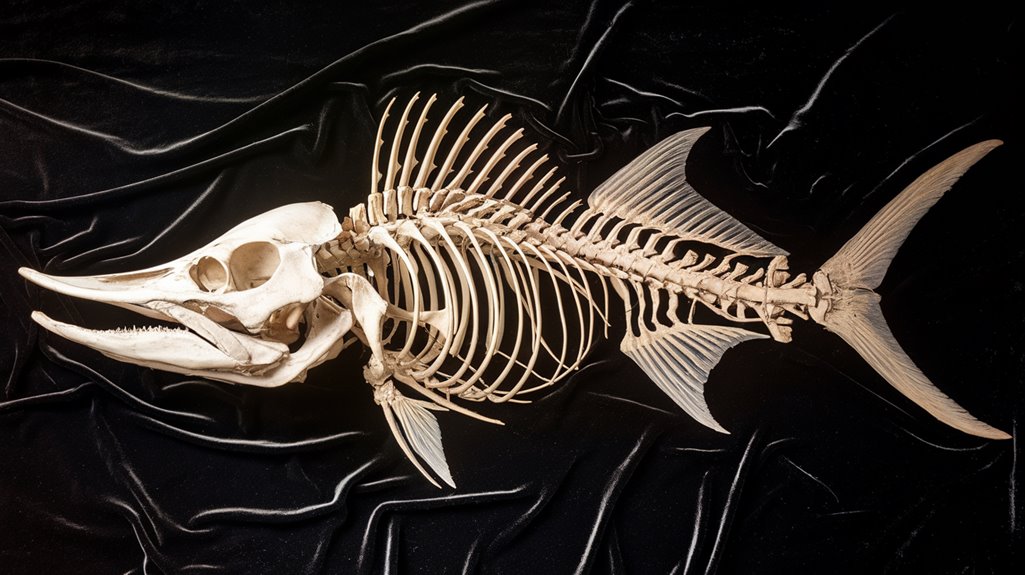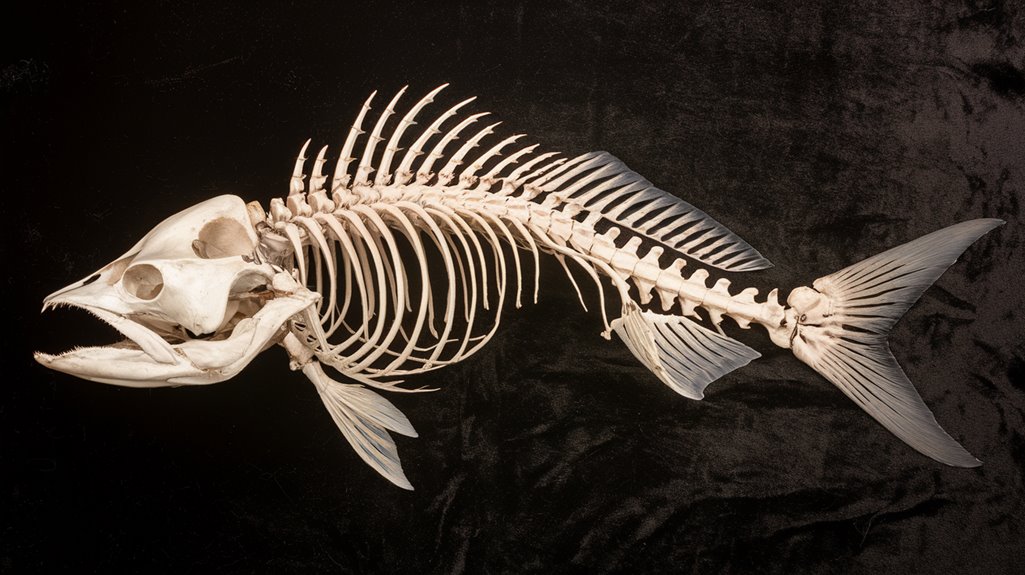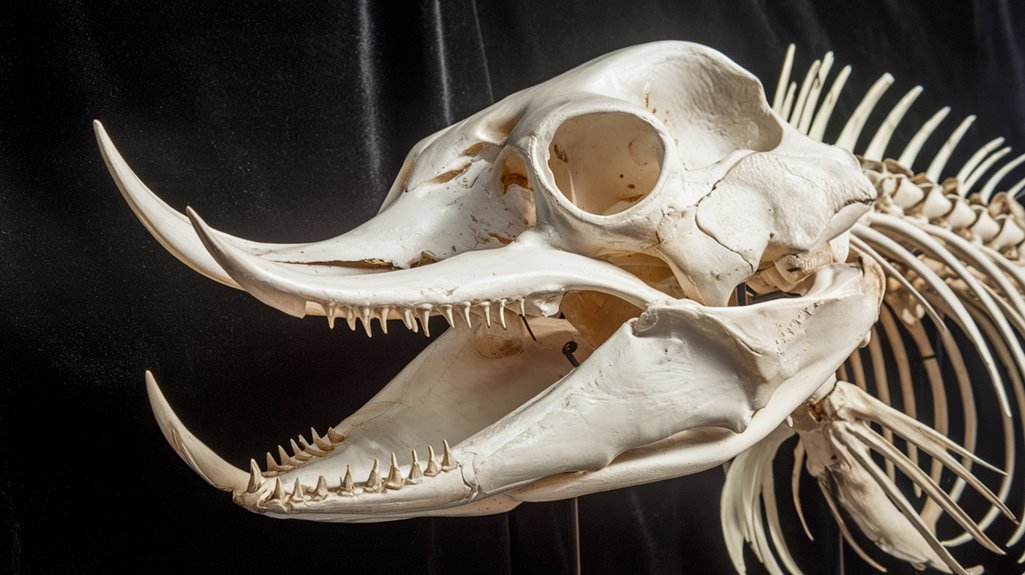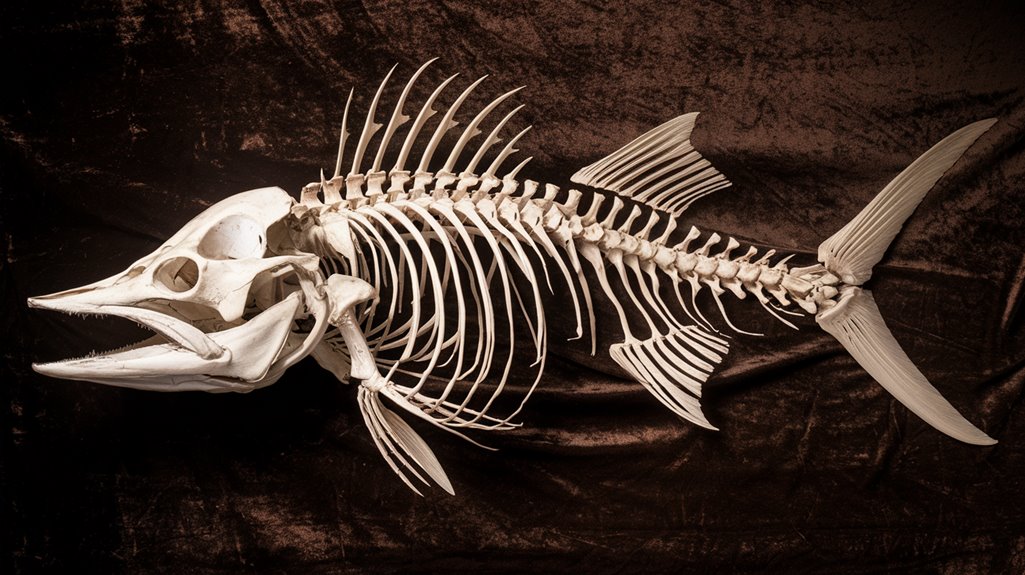When you examine a tarpon's skeleton, you'll discover a masterpiece of evolutionary engineering that's persisted for over 100 million years. This prehistoric fish's bone structure reveals sophisticated adaptations, from its specialized jaw mechanics to its uniquely modified swim bladder system. You'll find evidence of remarkable survival strategies in every bone, scale, and vertebra – adaptations that continue to intrigue marine biologists and challenge our understanding of fish evolution.
- Key Takeaways
- The Ancient Origins of Tarpon Skeletal Structure
- Key Components of the Tarpon's Cranial Framework
- Vertebral Column and Mobility Adaptations
- Jaw Mechanics and Feeding Architecture
- Fin Structure and Swimming Dynamics
- Scale Formation and Protective Elements
- Growth Patterns in Tarpon Bone Development
- Comparative Analysis With Modern Fish Species
- Frequently Asked Questions
- Conclusion
Key Takeaways
- Tarpon skeletons feature 24-26 vertebrae enabling powerful swimming and leaps up to 10 feet high with speeds reaching 35 mph.
- The skull includes fused premaxillaries and a bony gular plate, creating an efficient vacuum-like feeding system for swallowing prey.
- Scales form 20-30 organized rows of thick, flat armor providing protection while creating the species' characteristic silvery appearance.
- Growth rings in bones track age progression, with key structures developing over 6-8 years until sexual maturity.
- The skeletal structure has remained largely unchanged for over 100 million years, maintaining primitive teleost features from the Cretaceous Period.
The Ancient Origins of Tarpon Skeletal Structure

While many modern fish species have undergone significant evolutionary changes, the tarpon's skeletal structure stands as a tribute to evolutionary resilience, remaining largely unmodified for over 100 million years. When you examine tarpon fossils from the Cretaceous Period, you'll notice their ancient origins are evident in their primitive teleost features. As a prehistoric fish, the tarpon's distinctive jaw structure, featuring robust maxillaries and dentaries, demonstrates remarkable evolutionary stability. You can trace their lineage through the genus Megalops, which reveals how their specialized skeletal system, including the unique swim bladder-respiratory connection, developed. Their elongated body design and armor-like scales aren't just modern adaptations but rather time-tested features that have guaranteed their survival across millions of years.
Key Components of the Tarpon's Cranial Framework
The tarpon's evolutionary durability extends prominently to its sophisticated cranial framework, which represents a masterpiece of biological engineering. You'll find the skull's architecture perfectly adapted for its feeding strategy, featuring a terminal mouth with fused premaxillaries and extended maxillaries that reach beyond the eyes.
| Cranial Component | Function |
|---|---|
| Maxilla & Supramaxillae | Enables whole-prey swallowing |
| Bony Gular Plate | Provides jaw support |
| Terminal Mouth | Facilitates prey capture |
| Fused Premaxillaries | Strengthens bite force |
| Extended Maxillaries | Increases jaw reach |
The lightweight construction of the tarpon's skull, combined with its streamlined design, enables remarkable agility and speed. This cranial framework includes a distinctive three-bone upper jaw structure that works in concert with the gular plate to optimize feeding efficiency.
Vertebral Column and Mobility Adaptations

You'll find the tarpon's vertebral column remarkable for its 24-26 vertebrae that provide essential spinal support, enabling both powerful swimming movements and spectacular leaps of up to 10 feet in height. The bone density and structural reinforcement of their vertebrae allow these fish to maintain stability while executing rapid directional changes and reaching speeds of 35 mph in pursuit of prey. Their specialized spinal structure, which begins with a notochord in early life stages, demonstrates evolutionary adaptations that support the tarpon's impressive mobility across diverse aquatic environments, from coastal waters to freshwater habitats.
Vertebral Flexibility During Leaps
Remarkably adapted for aerial maneuvers, tarpon possess a vertebral column that enables them to leap up to 10 feet above the water's surface. You'll find their unique skeletal structure features elongated vertebrae connected by soft tissues, maximizing flexibility while maintaining strength.
| Feature | Function | Benefit |
|---|---|---|
| Elongated Vertebrae | Increases bend radius | Enhanced turning ability |
| Flexible Joints | Enables twisting motion | Better aerial control |
| Soft Connective Tissue | Absorbs impact forces | Reduces injury risk |
| Extended Spine | Provides leverage | Greater jumping height |
| Elastic Properties | Stores energy | Rapid directional changes |
This vertebral flexibility proves vital when you're observing their acrobatic displays during predator encounters or fishing scenarios. The tarpon's ability to bend and twist mid-air demonstrates their remarkable adaptation to aquatic survival, combining both defensive and offensive strategies through their specialized vertebral structure.
Spinal Support For Swimming
Building upon their aerial capabilities, tarpon's vertebral structure serves an equally important role in their underwater movement. You'll find their vertebral column uniquely engineered with specialized neural spines that maximize muscle attachment, enabling these fish to generate substantial power during propulsion. The spinal design contributes to their impressive swimming speeds of up to 35 mph, while simultaneously providing essential buoyancy control for efficient movement through various water conditions.
What makes this structure particularly remarkable is how it maintains flexibility while delivering robust support. The vertebrae work in concert to facilitate smooth, powerful swimming motions, allowing tarpon to navigate both oxygen-poor environments and long-distance migrations. This advanced spinal architecture demonstrates nature's engineering at its finest, perfectly balancing structural integrity with the mobility demands of these athletic fish.
Bone Density And Movement
While most fish species rely on dense skeletal structures, tarpon have evolved a lighter bone composition that optimizes their movement capabilities. Their specialized vertebral structure combines low bone density with strategic adaptations that enhance their aquatic performance.
You'll find these key features in tarpon's skeletal system:
- Reduced vertebrae count creating a streamlined profile that maximizes swimming efficiency
- Low-density bones providing superior buoyancy control across varying water depths
- Intermuscular bone formations stabilizing the spine during rapid directional changes
- Specialized vertebral connections enabling exceptional range of motion while maintaining structural integrity
This unique combination of bone density and vertebral adaptations allows tarpon to execute their characteristic acrobatic leaps and swift swimming maneuvers while maintaining the necessary strength for their vigorous activities.
Jaw Mechanics and Feeding Architecture

Equipped with a sophisticated feeding apparatus, tarpons possess a jaw structure that epitomizes efficient prey capture mechanics. You'll notice their large, bony maxillaries extend beyond the eye, while their fused, non-protractile premaxillaries create a sturdy upper jaw foundation. The feeding architecture includes paired dentary bones that fuse at the front, forming a robust lower jaw.
When you examine their feeding mechanism, you'll find it operates like a vacuum system. Their small, densely packed teeth aren't designed for biting but rather complement their upturned mouths, enabling them to swallow prey whole. This jaw mechanics configuration allows tarpons to effectively inhale fish and crustaceans, demonstrating how their skeletal structure has evolved to support their distinctive feeding strategy.
Fin Structure and Swimming Dynamics
You'll find that tarpon's fin rays exhibit a remarkable structural design, with strong, segmented elements that flex and compress during powerful swimming motions. The interconnected ray system works in concert with the fish's muscular control, allowing you to observe how each fin generates precise forces for propulsion and maneuverability. When you examine the fin structure closely, you'll notice how the rays' graduated lengths and specialized joints enable the characteristic thrust patterns that make tarpon exceptional swimmers.
Powerful Fin Ray Design
Through millions of years of evolution, tarpons have developed an extraordinary fin structure that combines soft and spiny rays to achieve maximum propulsion and maneuverability in water. Their fin ray structure enables remarkable agility and speed, making them formidable predators and skilled escape artists.
You'll find these key adaptations in their fin design:
- Large, flexible pectoral fins that provide precise control during complex swimming maneuvers
- Strategically positioned pelvic fins that maintain balance during aerial acrobatics
- Deeply forked caudal fin that generates thrust for speeds up to 35 mph
- Specialized combination of soft and spiny rays that deliver both power and flexibility
These features work together to create a highly efficient swimming system that's equally effective for endurance swimming and explosive bursts of speed.
Swimming Force And Motion
While many fish species rely on basic swimming mechanics, tarpons demonstrate a sophisticated integration of fin structure and body dynamics that produces remarkable aquatic performance. You'll find their large body employs multiple adaptations that generate exceptional swimming force. Their forked tail enables speeds up to 35 mph and facilitates spectacular aerial displays. The strategic placement of their dorsal fin, positioned toward the rear, enhances their ability to execute rapid directional changes. You'll notice their pectoral fins provide exceptional stability and maneuverability across diverse aquatic conditions. Their streamlined, laterally compressed form minimizes water resistance, while their muscular frame works in concert with their fin configuration to deliver powerful thrust—essential for both predator evasion and hunting success.
Scale Formation and Protective Elements
As one of nature's most effective defense mechanisms, tarpon scales form an intricate armor system that combines strength with flexibility. You'll find these protective plates arranged in 20-30 organized rows along their bodies, each scale surrounded by a thin skin layer that enables fluid movement.
The scales' composition and structure follow a precise architectural pattern:
- Their flat, thick design creates a robust external shield against predators
- A specialized blend of collagen and minerals guarantees both durability and strength
- The scales' reflective surface produces a silvery sheen, deterring threats
- A regenerative process maintains the protective system even after damage
This remarkable scale formation exemplifies evolutionary engineering at its finest, where you'll observe the perfect balance between defensive capability and practical functionality.
Growth Patterns in Tarpon Bone Development
When examining tarpon bone development, you'll observe a distinctly measured growth pattern that defines their skeletal maturation process. You'll find that growth rings in tarpon bones reveal their age progression, much like tree rings, while their bone structure evolves to support enhanced feeding mechanics. The development of key bone structures takes 6-8 years until sexual maturity.
| Bone Structure | Development Pattern |
|---|---|
| Dentaries | Fusion at anterior ends |
| Maxillaries | Extension past eye in adults |
| Gular Plate | Progressive lengthening |
| Premaxillaries | Shape differentiation |
| Growth Rings | Annual layer formation |
The fusion of dentaries and extension of maxillaries directly influences their feeding capabilities, while the gular plate's development enhances overall jaw efficiency. You'll notice these changes occur gradually, reflecting the tarpon's measured growth rate and adaptation to their feeding requirements.
Comparative Analysis With Modern Fish Species
Through comparative analysis of tarpon and modern fish species, you'll find significant structural differences that highlight the tarpon's ancient lineage. The tarpon's primitive skeletal structure has remained largely unchanged for over 100 million years, setting it apart from contemporary fish species.
Key differences between tarpon and modern fish include:
- The tarpon's bony jaw and specialized maxillary bones contrast with the more flexible jaw structures found in modern fish like salmon and trout
- Their fused dentary bones create a unique feeding mechanism unlike the mobile jaw structures of contemporary species
- A modified swim bladder connects to their respiratory system, whereas modern fish typically rely solely on gills
- Large, reflective scales and absence of spines serve as defense mechanisms, differing from modern fish that use camouflage or speed
Frequently Asked Questions
What Is Special About Tarpon?
You'll find tarpon remarkable for their specialized air-breathing swim bladder, bony mouth structure, massive size reaching 300 pounds, ultraviolet vision, and distinctive reflective scales that aid their survival.
Do Alligators Eat Tarpon?
You'll find that alligators actively prey on tarpon, especially targeting juveniles in freshwater and brackish environments. While they'll readily consume smaller tarpon, they're less likely to attack large adult specimens.
What Is the Predator of a Tarpon?
You'll find that tarpon's main predators include sharks, which ambush them in coastal waters, alligators that target juveniles in freshwater areas, and porpoises that chase them during surface feeding.
Why Do Tarpons Jump Out of the Water?
You'll observe tarpons jumping to evade predators, shake off fishing hooks, enhance oxygen intake by gulping air, and participate in mating rituals. Their powerful, forked tails enable these impressive 10-foot leaps.
Conclusion
You'll find that the tarpon's skeletal architecture represents a masterful example of evolutionary engineering. Through your examination of its ancient origins, specialized jaw mechanics, and distinctive vertebral adaptations, you've observed how each component contributes to its remarkable survival capabilities. You can trace these structural elements through comparative analysis, revealing how the tarpon's skeleton continues to influence modern fish species' anatomical development.

